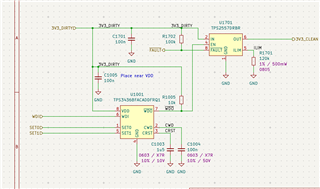Other Parts Discussed in Thread: TPS2552
Tool/software:
I have a circuit with a TPS2557 and a TPS3436BFACA. When I power it normally, it seems to work perfectly. However, when I bypass this circuit and apply 3.3V to the output (which I do for programming because I don't want the watchdog to interfere with programming), it seems like either the TPS2557 or TPS3436BFACA is breaking.

I am using the watchdog to control a power switch instead of connecting it to my microcontroller reset pin because I want to completely power cycle the entire board for my application.
When I say either the TPS2557 or TPS3436BFACA is breaking, I mean on some of my boards it seems like the TPS2557 is not working as specified and on others it seems like the TPS3436BFACA is not working as specified.
- Board 1: WDO never goes high. Conclusion: Watchdog broken, switch unknown.
- Board 2: Watchdog desoldered after strange behaviour noticed. WDO is always high (no watchdog chip to pull it down). The fault pin is high, but the switch output is low. Conclusion: Switch broken, watchdog unknown.
- Board 3: Trace cut between watchdog and pullup resistor. Switch works. EN is always high and the switch outputs 3.3V. If I connect an external pull up resistor between 3.3V and WDO, it is pulled low. Conclusion: Watchdog broken, switch works.
In every case, the watchdog was working perfectly before applying the reverse voltage.
The TPS2557 does not have any reverse voltage protection (unlike the TPS2552). However, it's not that the switch is powered but a higher voltage is applied at the output. In my case, the switch is unpowered. I would expect the MOSFET to be non-conducting. I did not think it would hurt anything to apply a voltage at the output. In the absolute maximum ratings, it says voltage from IN to OUT can be -7V to 7V.
As long as I don't power WDI, SET0, or SET1 while the watchdog has no power, I think I am staying within the maximum ratings of each chip. Did I miss something? What could be the problem?


